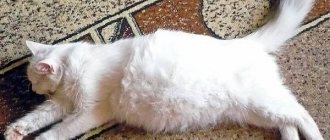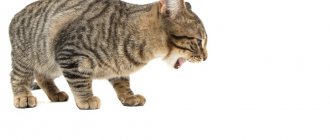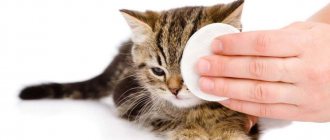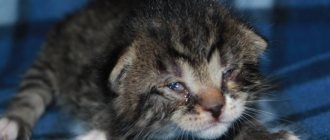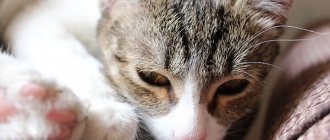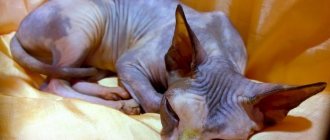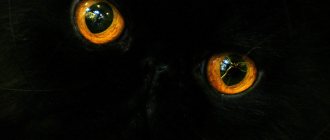Causes of a cloudy film on the eye
A cloudy film and a white spot on a cat’s eye occur for several reasons. In rare cases, a similar pathology may appear in kittens if an adult has been diagnosed with infectious diseases.
Cat's eyesore
The main reasons leading to the appearance of cloudy spots on the cornea are:
- problems in the functioning of the endocrine system;
- mechanical eye damage;
- lack of proper hygiene in the cat;
- improper nutrition of the pet;
- degeneration processes in the eyeballs;
- diseases caused by bacteria or fungi (often cause keratitis).
Important! Unfortunately, no animal is immune from the development of eye diseases, so it is recommended to carefully monitor the cat’s nutrition and condition.
Traumatic eye injury from claw
In addition, there are a number of diseases that negatively affect the animal’s eyes, resulting in clouding of the cornea.
- Corneal ulcer in a cat. Corneal ulcers often occur in cats. It is difficult not to notice such a phenomenon. The animal's lacrimation increases, the cornea swells, and blepharospasm is noted - an involuntary contraction of the eye muscles. The most common causes are injuries and chemical burns.
- Staphyloma. Staphyloma is a bulging cataract that occurs as a result of increased pressure in the eye.
- Cataracts in cats. This disease is diagnosed not only in older animals, but also in young animals. The main reasons are considered to be the presence of helminthic infestations and diabetes mellitus.
- Glaucoma. The cause of glaucoma is considered to be increased pressure inside the eyeball. All functions of the visual system are disrupted. The cornea becomes cloudy, severe pain appears, the eyelid swells, and hemorrhages are present in the tunica albuginea.
- Blepharitis in cats. Blepharitis is an inflammation of the eyelids. It is often confused with conjunctivitis, but such a disease is more difficult to cope with on your own. To make an accurate diagnosis, it is recommended to consult a doctor immediately.
- Leukoma. Leukoma is the formation of a scar on the cornea (thorn). The disease can be confused with cataracts, so it is recommended not to self-treat.
The thorn in any cat varies according to the course of the pathology:
- congenital. It appears infrequently, the causes are considered to be disturbances in the animal’s body during the period of intrauterine development. A cataract occurs in a kitten if there is an infection and viruses in the mother cat;
- acquired. A common form of the disease that occurs for various reasons.
The eyesore in domestic cats is also divided according to the type of location on the eye:
- peripheral. Does not affect the pupil area, is often located in the lateral part, looks like a white spot with black spots;
- central. The thorn is located in the very center of the eye, often blocking the pupil almost completely;
- total. In such a case, the thorn spreads over the cat’s eye completely.
Important! Eye diseases in cats must be treated promptly, otherwise the pet may completely lose vision.
Similar diseases
An incipient adenoma, the formation of a benign tumor in the corner of the eye, is often confused with prolapse of the third eyelid. At first it will be a film, but gradually the neoplasm will begin to grow, and soon the cat will not be able to close its eye. As a result, there is a risk of developing infectious diseases of the nictitating membrane. The tumor is removed surgically, often along with the third eyelid. This allows you to protect the animal from relapses, as well as from the appearance of a white film on the eye in old age. But there are also negative consequences: frequent conjunctivitis and lack of tear fluid.
Another disease with which prolapse of the nictitating membrane is confused is prolapse. It is associated with inflammation of the lacrimal gland, while the nictitating membrane is constantly in a straightened state. This causes discomfort to the cat: the animal perceives the film that appears on the eye as a nuisance, so it constantly rubs its muzzle with its paw. Unlike adenoma, prolapse is eliminated after treatment. Prolapse most often occurs in brachycephalic breeds.
Causes of cloudy eyes in cats: video
Pets see well not only in the light, but also in the dark, so it is important that the animal’s vision organs are always healthy. Unfortunately, it is not uncommon to diagnose such a problem as an eyesore in a cat. In such situations, it is recommended to find out the cause of the disease, then begin treatment.
What symptoms indicate illness?
Any pathological process in an animal’s body is accompanied by specific signs. It is recommended to pay attention to any changes in the behavior and appearance of the pet. Problems with cat vision are accompanied by the following symptoms:
- the animal has an increased secretion of tear fluid;
- the cat hides in dark places and does not tolerate bright light;
- the appearance of a purulent film and unpleasant discharge is noted;
- the cornea becomes cloudy and acquires a reddish tint;
- the pupil changes shape;
- often the cornea acquires an uneven color, the surface becomes loose;
- with some pathologies, the thorn becomes convex;
- blurred vision, strabismus;
- in advanced cases, complete atrophy of the visual organs occurs.
Your cat has worms: how to treat them at home
Cloudiness of the cornea of the eye
It is recommended to pay attention to your pet's behavior. The animal bumps into walls and has visual problems. The cat becomes irritable, does not want to communicate, often washes itself, trying to remove what interferes with normal vision. If your pet is inflamed, it is difficult to wash it; it causes pain.
Important! It is necessary to promptly notice any changes in the cat’s visual organs.
Advanced disease is more difficult to treat.
Diagnostics
If suspicious signs appear, it is recommended to contact a veterinarian. The doctor will conduct the necessary studies and determine an accurate diagnosis. Diagnosis of the disease includes:
- owner survey;
- visual examination of the cat's eyes;
- complete blood test of the animal;
- performing ophthalmoscopy;
- the use of specific substances for staining the cornea;
- Ultrasound examination of the organs of vision.
Third eyelid in a cat: causes, treatment at home
If necessary, additional examinations are carried out to make a more accurate diagnosis: scrapings, taking smears for bacteria, testing for viruses, measuring the pressure inside the eye.
Increased pressure in a cat's eye
After all the research, the veterinarian will make an accurate diagnosis and tell you how to treat the cat’s eyesore.
Important! It is not possible to make a diagnosis on your own. You can’t risk your pet’s health and not consult a doctor.
What to do
If you notice that the corner of your cat's eye has turned white, it's time to contact your veterinarian. Loss of the third eyelid is only a sign of health problems in the animal. It is possible that the nictitating membrane will return to its place on its own, but in most cases this pathology requires drug treatment.
Attention! So that the doctor has a complete picture of the disease, do not treat the pet yourself.
The main method of examination is the use of an ophthalmoscope. The doctor examines the patient and takes swabs of tears or purulent discharge to determine infection. Depending on the test results, treatment will be prescribed.
- Diseases of bacterial, viral and fungal etiology require complex therapy with the use of antibiotics, antiviral and antifungal drugs. In advanced conditions, it is possible to use antipyretics and immunostimulants.
- If you have problems with the gastrointestinal tract, it is enough to normalize your diet. At the beginning of treatment, special medicinal feed is used.
- For allergies, antihistamines are prescribed, as well as local hormonal therapy.
- If the appearance of a white film on the eye is associated with contact with a foreign body on the cornea, rinsing is carried out; in severe cases, the foreign irritant is removed surgically.
- For mechanical damage, pain relief and local wound treatment are indicated.
Any treatment requires time, during which the cat must be provided with complete rest. It is very important to complete the course, and not limit yourself to initial improvements in the condition.
When the nictitating membrane prolapses, medications are not necessarily used. A number of cases do not require medication:
- The appearance of a white eye due to decreased immunity. In this case, there will be no discharge from the eyes. It is enough to provide the animal with a balanced diet rich in vitamins.
- The recovery period after a viral or infectious disease. In this case, it is necessary to regularly wash the cat's eyes to remove exudate.
- In case of dehydration: you need to provide your pet with drink and wet food.
A cat's eyesore: how to treat it
When treating a cataract, you must strictly follow all doctor’s prescriptions. Proper and timely therapy will help relieve the animal of unpleasant sensations and normalize visual functions.
Drug therapy
The cat's eyes are watery: what to do at home
In most cases, conservative treatment is used using various medications:
- eye drops or ointments (tetracycline, floxal) are prescribed, which are used for at least two weeks;
- antibacterial agents are applied to the lower eyelid area, the procedure is repeated morning and evening, the interval should be the same. Therapy continues for up to 14 days;
- if the cause of the disease is injury, then first wash the eye with a disinfecting solution (chlorhexidine, miramistin), then instill medicinal drops (chloramphenicol);
- severe painful sensations are relieved by injecting special anesthetic solutions into the eyeball. It is permissible to repeat the procedure if necessary;
- for increased pressure in the eyeball, the drugs pilocarpine and brinzolamide are prescribed.
All prescribed medications are used in a comprehensive manner, this will help you quickly get the desired result and cure your cat.
Eye drops
For your information! If conservative treatment does not give the desired effect, or the disease is diagnosed in an advanced form, surgical intervention is prescribed. Keratoplasty is often performed, during which the cornea is completely replaced.
In some cases, the edges of a cat's eyelids are sutured - tarsography. This procedure speeds up the healing process and protects the cornea of the eye.
It is necessary to carefully follow all appointments so that the restoration of the visual organs occurs faster. It is worth remembering that the disease cannot go away in a few days.
Treatment with traditional methods at home
Treatment of cataracts in a kitten at home can be carried out using folk remedies. However, they are used in conjunction with drug therapy.
A medicinal solution made from honey is considered popular in this case. How to prepare it:
- A small amount of sweetness is dissolved in water (powdered sugar can be used instead of honey).
- Mix thoroughly to obtain a homogeneous liquid.
- Drop 3 drops into the affected eye daily until complete healing.
Unfortunately, such a remedy will not have an effect if the cause of the disease is an infection.
Advanced eye disease in a cat
Important! You cannot use any folk remedies without the consent of your veterinarian. Wrong actions can lead to exacerbation of the disease.
Treatment
Under no circumstances should you start treatment without consulting a specialist. You may make the disease worse and cause serious complications. Therapy is prescribed based on an examination by an ophthalmologist, who will determine the extent of the damage.
Bacterial keratitis must be treated with antibiotics. Sulfonamide drugs are mainly used in the form of drops. In acute cases, the doctor must inject hydrocortisone into the area of the conjunctival sac. Novocaine can also be administered to relieve pain.
For home use, it is necessary to use antiseptic rinsing solutions - 1% solution of furatsilin or boric acid.
If keratitis is viral, antiviral drops and ointments are used, for example, acyclovir or Zovirax.
The pet should be supplemented with vitamins by providing a full menu and a separate addition of tableted vitamins.
Preventive measures
It is easier to prevent any disease than to treat it later. Prevention of visual problems in cats includes the following points:
- you need to carefully monitor your pet’s nutrition and care;
- exclude animal contact with household chemicals and hazardous substances;
- trim claws on time;
- during walks, they carefully monitor the pet’s behavior and its contacts;
- receive all necessary vaccinations on time;
- periodically visit a veterinarian, this will allow you to identify the disease in the initial stages,
It is recommended to remember that timely treatment will help maintain the health of your furry pet.
A cat's eyesore is a dangerous condition that can result in the animal losing its sight. When the first suspicious signs appear, you should immediately contact a veterinarian. In treatment, it is important to follow all the specialist’s instructions and carry out procedures strictly according to the instructions. Compliance with preventive rules will help avoid pathologies.
Video
Prevention measures
If your cat has already had problems with prolapse of the third eyelid, you can try to prevent the development of the disease. It is especially important to know about preventive measures when caring for an older cat.
- Your pet's diet should be balanced.
- Regular examination of the cat after a walk to check for mechanical damage to the eyes and foreign bodies.
- Carrying out antiparasitic treatment.
- Routine examination by a veterinarian.
- Regular eye rinsing.
